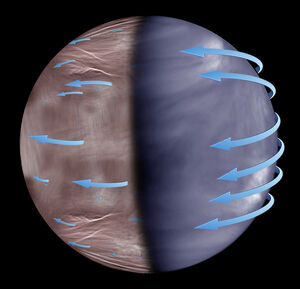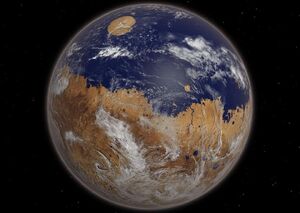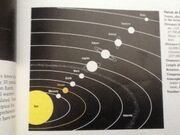| Mercury > Venus > Earth |
- "I'm the brightest and the hottest planet."
- — Venus
Venus is the second planet from the Sun, orbiting it every 224.7 Earth days.[15] It has the longest rotation period (243 days) of any planet in the Solar System and rotates in the opposite direction to most other planets. It has no natural satellite. It is named after the Roman goddess of love and beauty. It is the second-brightest natural object in the night sky after the Moon, reaching an apparent magnitude of −4.6, bright enough to cast shadows.[16] Because Venus is an inferior planet from Earth, it never appears to venture far from the Sun; its elongation reaches a maximum of 47.8°.
Environment
Venus is a terrestrial planet similar to Earth in size, mass, proximity to the Sun, and bulk composition. Its gravity is 8.87 m/s2, the equivalent to about 90% of Earth’s gravity.[17] A "day" on Venus is 243 Earth days.[18] One day-night cycle takes 117 Earth days because Venus rotates in the direction opposite of its orbital revolution around the Sun.[19] Venus receives an enormous amount of sunlight before it finally rotates over to the night side.[20] Nightside surface temperatures are relatively colder at higher altitude regions as compared to lower altitude regions.[21]
Venus is by far the hottest planet in the Solar System, with a mean surface temperature of 737 K (464 °C; 867 °F). Its atmosphere is made up of 96.5% CO2, with surface pressure about 90 times higher than on Earth. At this pressure, CO2 is highly absorbing both at 15 microns and near 5 microns = 5000nm. CO2 absorbs infrared radiation, but does not all escape into space. Much of the CO2 is trapped between the surface and CO2 layers in the atmosphere. Thus, the atmosphere is incredibly hot and maintains high surface temperatures.[22]

Venus has the slowest rotation of any major planet in our Solar System. It spins only once every 243 Earth days. So “night” or “day” on the planet last a very long time, thus the characteristics of Venusian night and day undergo differences. The European Space Agency (ESA) stated on September 14, 2017 that scientists have used data from the Venus Express spacecraft to characterize the wind and upper cloud patterns on the night side of Venus for the first time. They said the results were “surprising.” They discovered that cloud patterns are different on the night side, compared to those on the dayside, influenced by Venus’ topography.[23]
Venus’ atmosphere is dominated by strong winds that whirl around the planet far faster than Venus itself rotates. This phenomenon, known as super-rotation, sees Venusian winds rotating up to 60 times faster than the planet below, pushing and dragging along clouds within the atmosphere as they go. These clouds travel fastest at the upper cloud level, about 40 miles (65 km) above the surface.[23]
Super-rotation seems to be more irregular and chaotic on the night side, according to J. Peralta and R. Hueso, ESA. They say that night side upper clouds form different shapes and morphologies than those found elsewhere on Venus. They found large, wavy, patchy, irregular, and filament-like patterns, many of which are unseen in dayside images. What’s more, the night side clouds are dominated by unmoving phenomena known as standing waves, or stationary waves. Agustin Sánchez-Lavega of University del País Vasco in Bilbao, Spain explains: "Stationary waves are probably what we’d call gravity waves. In other words, they are rising waves generated lower in Venus’ atmosphere that appear not to move with the planet’s rotation. These waves are concentrated over steep, mountainous areas of Venus; this suggests that the planet’s topography is affecting what happens way up above in the clouds."[23]
Once habitable

It’s believed that Venus had ocean water at one time, but is now lost. Any water originally on Venus boiled into the atmosphere and had been broken apart by ultraviolet light from the Sun. The hydrogen has escaped so water cannot form again. Without having oceans, Venus could no longer suppress atmospheric CO2 and was doomed to develop an extreme greenhouse effect. On Earth, ocean water controls the greenhouse effect by absorbing much of the CO2.[22]
Venus is a hallmark in every human mythology as recorded in unearthed script from Sumeria, to Egypt, to MesoAmerica. There are reports that suggest that Venus was once inhabited. Due to the current toxic enviromental conditions, it is highly doubtful that their is life on Venus at present. Venus today is a hellish world. It has a crushing carbon dioxide atmosphere 90 times as thick as Earth’s. There is almost no water vapor. Temperatures reach 864 degrees Fahrenheit (462 degrees Celsius) at its surface.[24]
Being in the habitable zone, Venus may have supported life as early as 2 billion years ago. Computer modeling of the planet’s ancient climate, conveys shallow liquid-water oceans and habitable surface temperatures in its early history. The shallow water theory is based on the proximity of Venus to the Sun, which receives far more sunlight than Earth. The early habitat theory is based on ancient climate analysis performed by NASA’s Goddard Institute for Space Studies (GISS) in New York [24]
At a glance

- Distance: 43,000,000 miles
- Diameter: 6,521 miles
- Length of year: 225 to 243 earth-days.
- Rotation period: 23 hours & 21 minutes
- Temperature: 864°F to 932°F
- Atmosphere: Carbon dioxide (CO2), nitrogen (N2), water vapor (H2O and climate variable), argon (18Ar), carbon monoxide (CO), neon (10Ne), sulfur dioxide (SO2).
- Number of satellites: None.
- Type: Overheated terrestrial planet.
Trivia
- Venus is the only terrestrial planet to rotate backwards.
- Venus has the longest day of any planet: 243 days.
- Second planet from the Sun.
- Hottest planet in the Solar System.
- Orbits around the Sun backwards.
- Venus has a very thick atmosphere.
- Has no moon.
- Has a very new surface.
- It is named after the Roman goddess of love and beauty: Venus.
Gallery
References
- ↑ 1.0 1.1 1.2 1.3 1.4 1.5 1.6 1.7 Cite error: Invalid
<ref>tag; no text was provided for refs namedfact - ↑ Cite error: Invalid
<ref>tag; no text was provided for refs namedhorizons - ↑ 3.0 3.1 Cite error: Invalid
<ref>tag; no text was provided for refs namedVSOP87 - ↑ Cite error: Invalid
<ref>tag; no text was provided for refs namedSouami_Souchay_2012 - ↑ 5.0 5.1 Cite error: Invalid
<ref>tag; no text was provided for refs namedSeidelmann2007 - ↑ Cite error: Invalid
<ref>tag; no text was provided for refs namedKonopliv1999 - ↑ "Planets and Pluto: Physical Characteristics". NASA. 5 November 2008. http://ssd.jpl.nasa.gov/?planet_phys_par.
- ↑ Cite error: Invalid
<ref>tag; no text was provided for refs namediauwg_ccrsps2000 - ↑ Cite error: Invalid
<ref>tag; no text was provided for refs namedMallama_et_al - ↑ Cite error: Invalid
<ref>tag; no text was provided for refs namedHaus_et_al - ↑ Cite error: Invalid
<ref>tag; no text was provided for refs namedMallama_and_Hilton - ↑ Template:LexicoTemplate:BreakTemplate:MW
- ↑ Template:OED
- ↑ Template:OED
- ↑ Cite error: Invalid
<ref>tag; no text was provided for refs namednasa_venus - ↑ Lawrence, Pete (2005). "In Search of the Venusian Shadow". http://www.digitalsky.org.uk/venus/shadow-of-venus.html. Retrieved 13 June 2012.
- ↑ https://www.universetoday.com/14245/what-is-the-gravity-on-venus/
- ↑ Wikipedia, Venus
- ↑ NASA, Venus
- ↑ Popular Mechanics, Scientists Reveal Mysteries on the Night Side of Venus BY JAY BENNETT, SEP 15, 2017
- ↑ Nature, Venus nightside surface temperature, D. Singh
- ↑ 22.0 22.1 Arizona.edu, G. H. Rieke, Venus lecture
- ↑ 23.0 23.1 23.2 Earth Sky, Venus’ mysterious night side revealed by Deborah Byrd, September 16, 2017
- ↑ 24.0 24.1 NASA Climate Modeling Suggests Venus May Have Been Habitable
Resources
- Map-a-Planet: Venus by the U.S. Geological Survey
- Gazeteer of Planetary Nomenclature: Venus by the International Astronomical Union
- Venus crater database by the Lunar and Planetary Institute
- Map of Venus by Eötvös Loránd University
- tivas.org.uk
- wiki.answers.com
- Wikipedia.org
- solarsystem.nasa.gov
- Venus profile at NASA's Solar System Exploration site
- Missions to Venus and Image catalog at the National Space Science Data Center
- Soviet Exploration of Venus and Image catalog at Mentallandscape.com
- Venus page at The Nine Planets
- Transits of Venus at NASA.gov
- Geody Venus, a search engine for surface features
Cite error: <ref> tags exist for a group named "note", but no corresponding <references group="note"/> tag was found

